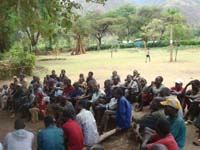14.1 Implementation
The word ‘implementation’ means to carry out. It is the act of converting your planning, goals, objectives and strategies into action. In other words, it is converting your planned activities into action — according to a plan of work. Conducting health education activities at a community gathering, or during home visits, are examples of implementation, or carrying out health education activities.
Community members should be involved in all your health education activities whenever possible. This should improve the uptake of your health education interventions, and enable you to pool community resources, including labour power. If the community seems reluctant to participate in health education activities, your plans stand much less chance of being successfully implemented. In order to avoid this difficulty, you should try to make sure that as many members of the community as possible are ready to participate in health education activities. To ensure participation, you should organise the community, and discuss with them the issues that you feel are important for the implementation of health education activities in their locality.
Box 14.1 Community organising
Community organising is the process of sensitising and empowering the community in such a way that they can identify and prioritise their needs and objectives. This will help them develop confidence and find resources through collaborative practices and community participation. Organising means bringing the community together for collective action.
Now look carefully at Box 14.1 above which describes what is meant by community organising. Think of a number of ways that you could organise health education activities in your own community.
To bring together the community, you will appreciate that being in touch with a wide range of groups with different interests will have the best chance of succeeding. Another well-known phrase is, ‘it takes all sorts of people to make the world’, and the many different people in your community may like many different activities, or come to health education from very different backgrounds. Organisation involves getting people involved in some way that feels right for them — in order that they can move forward to collective action.
When health workers or others organise their community, they build relationships among all those people who have common values, and who can participate in sustained social action (Figure 14.1). Therefore, community organising can be seen as the process of empowering individuals for collective action. When people become organised, they almost always feel commitment, and move forward together to achieve common goals. This is especially important in your work in improving the health of your community.

Learning Outcomes for Study Session 14
